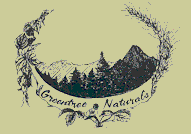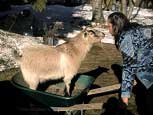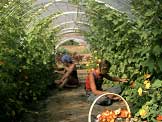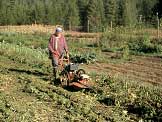 |
 |
 |
 |
 |
 |
 |
 |
 |
 |
|
Summer 2006 Newsletter
July 1st~We rescued two Pygmy goat brothers eight years ago from going to become taco meat and named them Stanley and Ollie. Stanley was by far the sweetest little guy of our three billie goats that we have. The farm that we liberated them from had thirty goats in a pen the size that we held three, so our little guys have a nice space to call their own. We have the goats for their wonderful manure; other than that, they are pets. I take them for a walk every day, and have for many years. We have acres of forest adjacent to our farm, so there are plenty of safe places to walk. They stay close by me and actually come to a whistle like the dogs! It is not unusual for the daily afternoon goat walk to include the two dogs, one or two of the cats and this one chicken named Lucy who insists on flying out of the chicken yard every day. Lucy also loves hanging with the goats and has decided that riding on the back of Butch, the Nubian, to be a favorite pastime. Butch likes it because she walks up and back and scratches his back. Of course, every time I take the camera out to catch the opportune moment for the perfect photo to share, Lucy flies off. About a year ago, Stanley starting going lame with severe arthritis. After talking with numerous goat dairies, I have learned that this is pretty normal with goats when they reach 7 or 8 years old. When Stanley quit going on our daily walks, I knew that it was only a matter of time that he would have to be put out of his misery. I ended up shortening the walks with the other two goats because Stanley would get so upset when he could not come with us. I always gave him the option, but his ailment made it impossible. Today, while I was at the farmers market, Thom did what had to be done and laid Stanley to rest. We both cried and were surprised to acknowledge how close we have become to these fellow creatures of the farm. He was buried next to a young cherry tree and will return to the earth as all of us will when our time is come.
The warm weather has made the gardens explode with growth. The 4th of July may be a holiday for some; for us, it is our usual Tuesday harvest day that will bring a share of the gardens bounty to our CSA’s for their first sugar snap peas, snow peas, broccoli, along with repeats of kohlrabi, salad mix, radishes, strawberries, onions and maybe the first of the summer squash. One of the lovely things about where we live is the wildlife visitors. Most of our sightings are early mornings. Just this morning, I watched a mother deer cautiously wander about the lower fields, looking like she was searching for something, when sure enough; a brand new baby came popping out of the brush. It is likely that the little one was hunkered down and hiding, waiting for mom to return for it. Often times mother deer will somehow relate to their offspring in times of trouble, to lay down while she runs away to deter whatever is chasing them away from finding the little one that is too young to run fast or far. It was so sweet as they reunited, the little one wagged its tail with a fury as it nursed for its morning breakfast. What a great way to start the day! July 9 ~The snow peas are bountiful and the sugar snaps are over six foot tall! We hosted an Ag in the Classroom farm tour last week with 42 teachers from across the northern part of the state. One of the ag specialists asked what kind of ‘poplar trees’ we were growing, mistaking the six foot sugar snap peas for trees and stating “I’ve never seen peas that tall!” It is a bit odd to be harvesting what is typically a spring crop in July, but this is northern Idaho and just a little different than the rest of the world. While picking peas, we found many lady bugs in the process of laying eggs, which was quite a wonder to witness. I have often found their eggs, but never seen them in the act of laying them. Too bad we don’t have a digital camera with a zoom to get close up to share the event with you. August 6~Summertime in full swing with the abundance of the gardens filling our CSA bags every week. The garlic is out of the ground and hangs waiting to be cleaned for sale. We are coming on to week ten of our CSA deliveries, which means we have six more weeks to go with the CSA’s. The peas continue to survive weeks of 100+ degree temperatures. We are convinced that this is because we have been saving our own seed for both varieties and they have adapted to our micro-climate to be more heat tolerant. We have never harvested peas so late in the season. The beans are flowering and will be ready for first harvest soon. August 12 ~With the last harvest of sugar snap and snow peas in the CSA bags, the beans are just starting to thrive. We have four double 120 foot rows, four different kinds of beans. We grew the cucumbers on arbors inside one of the hoop houses this year as an experiment and it has turned out to be a fantastic way to grow cukes. We have grown them on trellis for years, but this is new to us.
September 20 ~
Once the frost killed the beans off, I chopped everything up of the bean plants. We will follow by using the roto-tiller to till all of it in for green manure and organic matter. This is the first time we have done it this way, so I will have to keep you posted on how well it works out. All I can say is, it feels good to be at the end of the growing season! We are looking forward to winter. Always do. Meanwhile, we still have to put the garden to bed, plant the garlic, and attempt to get the greenhouse project underway before the snow flies. The goal is to get the greenhouse up and ready to go for growing in the springtime. Also have to get the other well going, all of which I talked about in the spring newsletter. Well, still has to get done. The thing is, there never seems to be enough time to do everything we need to do. So, we establish daily priorities, and always do as much as we can….and then do some more. As we finish up with the gardening season, I am starting travels to teach workshops on assorted small farm, sustainable ag subjects. I will be involved in a project with Rural Roots developing and teaching workshops on managing liability on the small farm along with a couple of direct marketing the small farm. Thankfully, I will be working with a great team of some of the Board of Directors of Rural Roots, who are all farmers and salt of the earth folks.
|
2003 Rapid Lightning Road, Sandpoint, Idaho 83864 • 208-263-8957 • info@greentreenaturals.com
Site Design by Logical Expressions, Inc.


 I have decided to try a new way to write the newsletter this time and write a little here and there as a journal of the seasons passing. This may prove to be a more lengthy expression of what life on the farm is like, but I am willing to share perspectives.
I have decided to try a new way to write the newsletter this time and write a little here and there as a journal of the seasons passing. This may prove to be a more lengthy expression of what life on the farm is like, but I am willing to share perspectives.
 The cucumbers hang down for easy harvest.
The cucumbers hang down for easy harvest.  It appears that my thought of writing a journal through the season was not as successful as I had hoped. Once the bean harvest started, it seemed that we were doing little else. We managed to harvest over 500 pounds of beans in the past five weeks. When the frost came last Saturday night, we rejoiced that the beans were done! This is a labor intensive crop, but worth the effort for the market price. And, who doesn’t like green beans? We grow Italian, French Haricot Verts, Golden Haricot Verts and the standard American. The term “beans coming out your ears” is an odd expression, but we have all come to relate clearly to the saying.
It appears that my thought of writing a journal through the season was not as successful as I had hoped. Once the bean harvest started, it seemed that we were doing little else. We managed to harvest over 500 pounds of beans in the past five weeks. When the frost came last Saturday night, we rejoiced that the beans were done! This is a labor intensive crop, but worth the effort for the market price. And, who doesn’t like green beans? We grow Italian, French Haricot Verts, Golden Haricot Verts and the standard American. The term “beans coming out your ears” is an odd expression, but we have all come to relate clearly to the saying. By the forth week of bean harvest, we were all getting into daily ‘bean wars’. As we harvest, we toss the curled beans at each other. If you toss them just right, and your opponent is wearing a cotton shirt, the beans will stick to your shirt. Emily, Thom and I had many a bean battle. One day, Thom covered his hat and shirt with bean leaves (the leaves will stick to you too) and crawled on his belly in the dirt for about 30 feet, trying to sneak up on me. He might have made a surprise attack, but Emily started laughing and I figured it out. Needless to say, I was picking beans out of my hair and off my clothes at lunchtime. You really have to keep your since of humor about the chores at hand!
By the forth week of bean harvest, we were all getting into daily ‘bean wars’. As we harvest, we toss the curled beans at each other. If you toss them just right, and your opponent is wearing a cotton shirt, the beans will stick to your shirt. Emily, Thom and I had many a bean battle. One day, Thom covered his hat and shirt with bean leaves (the leaves will stick to you too) and crawled on his belly in the dirt for about 30 feet, trying to sneak up on me. He might have made a surprise attack, but Emily started laughing and I figured it out. Needless to say, I was picking beans out of my hair and off my clothes at lunchtime. You really have to keep your since of humor about the chores at hand!